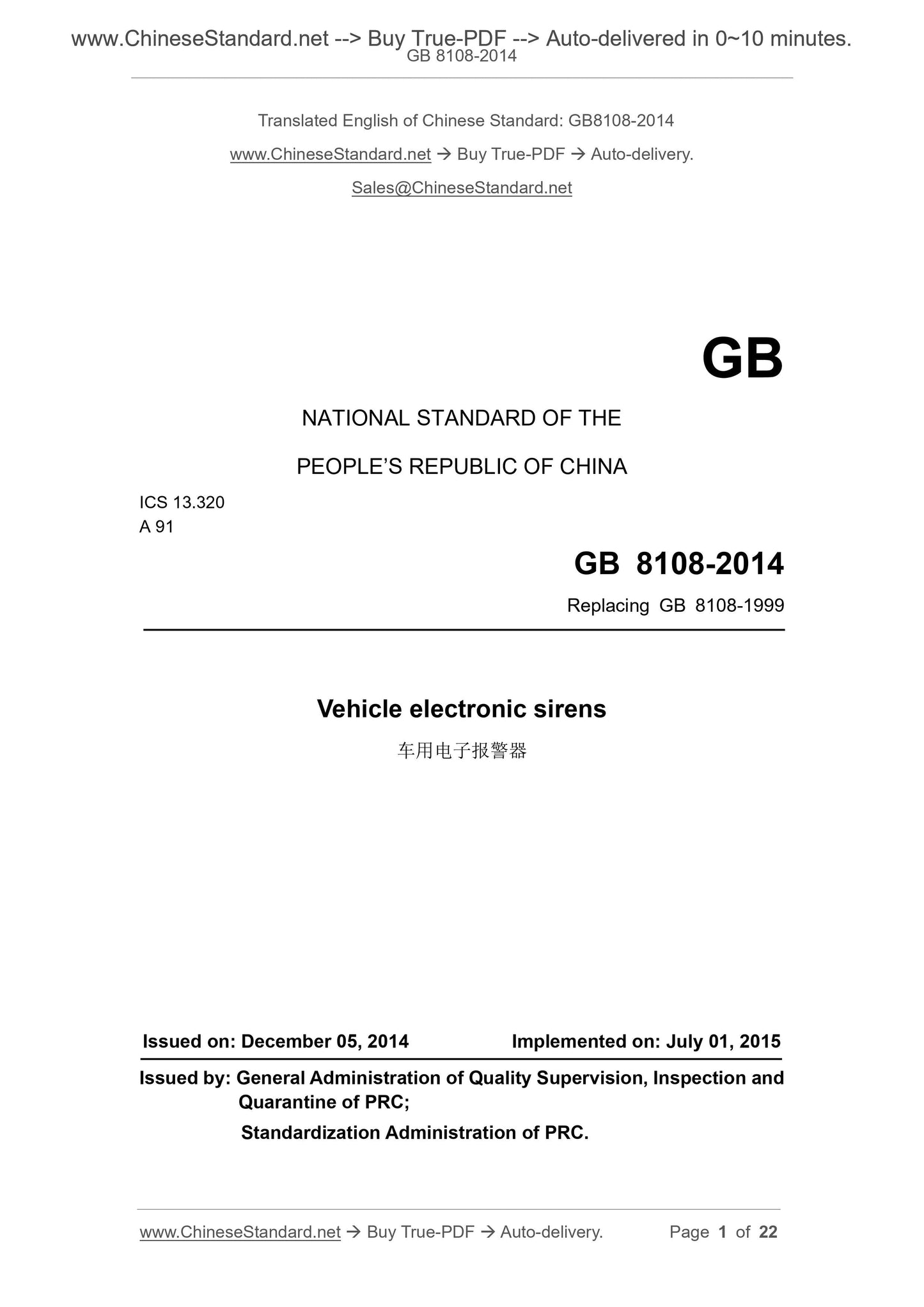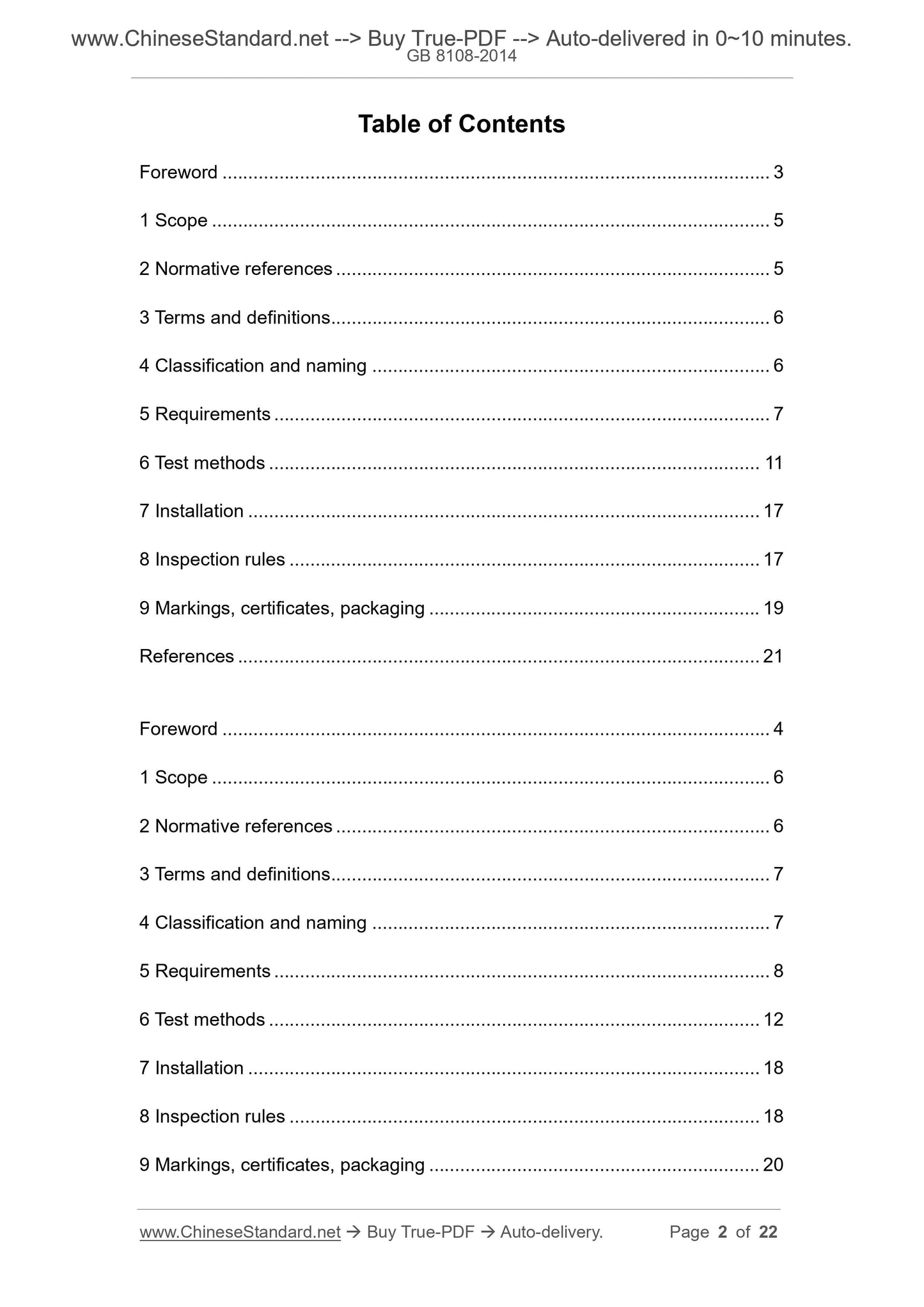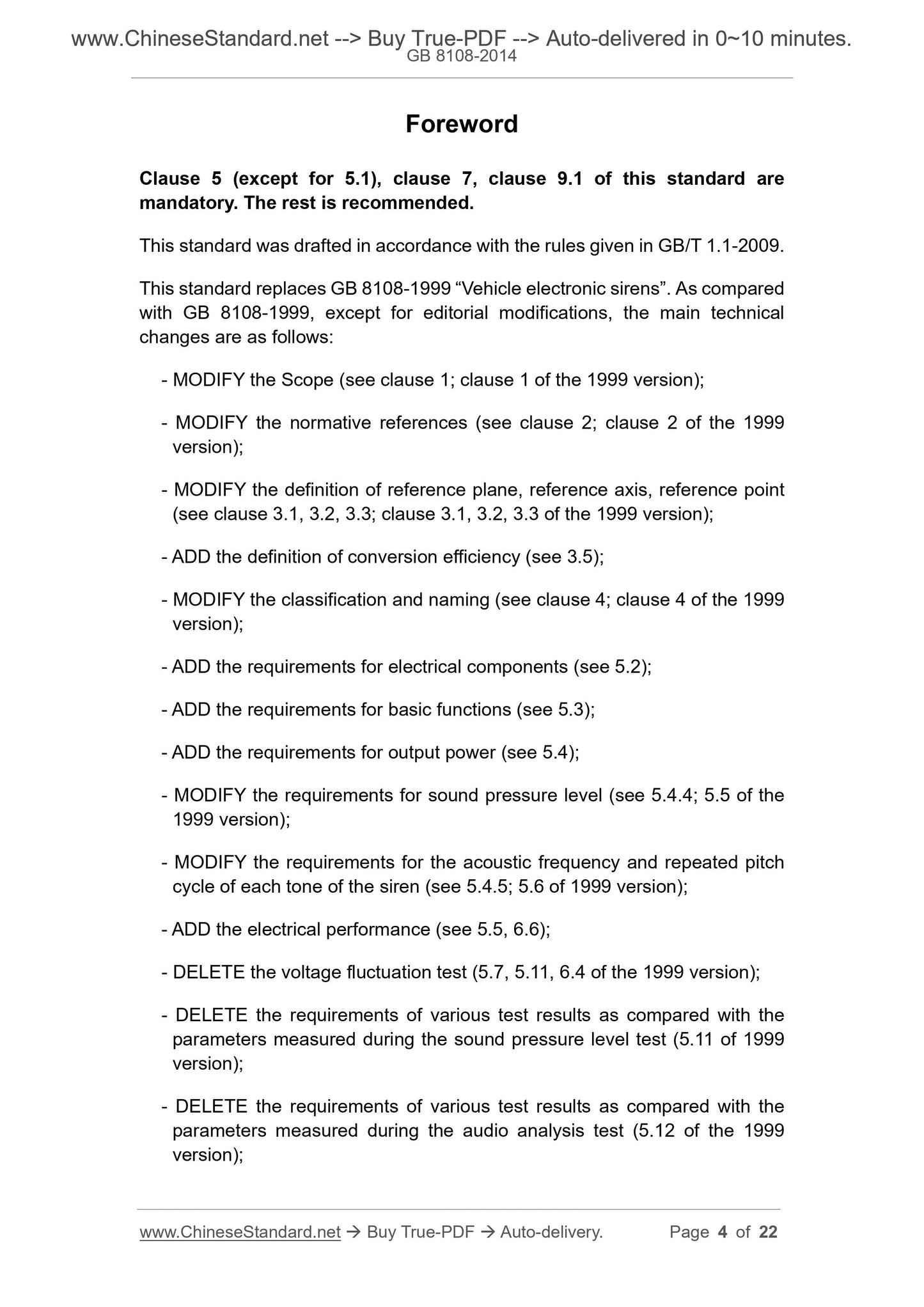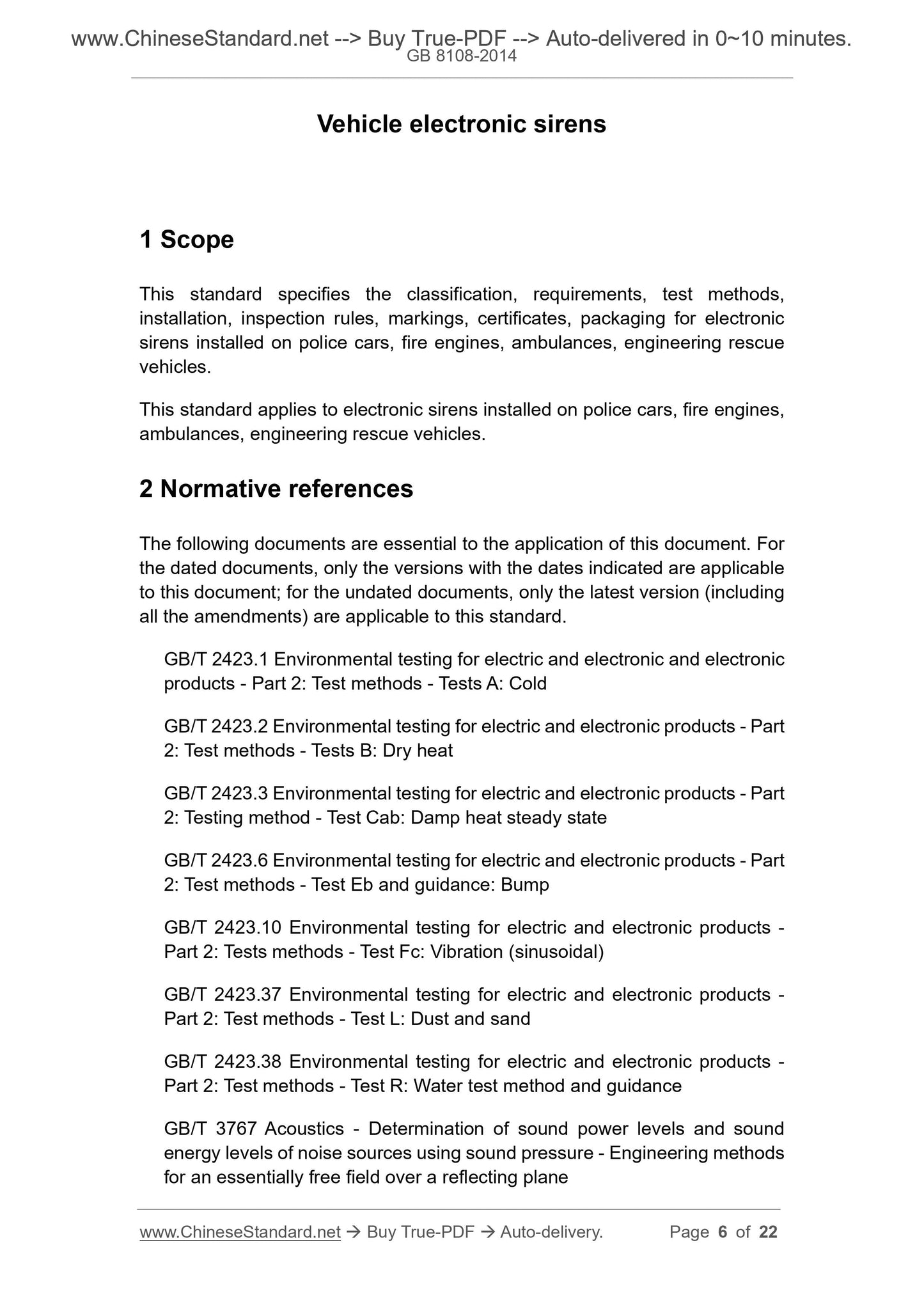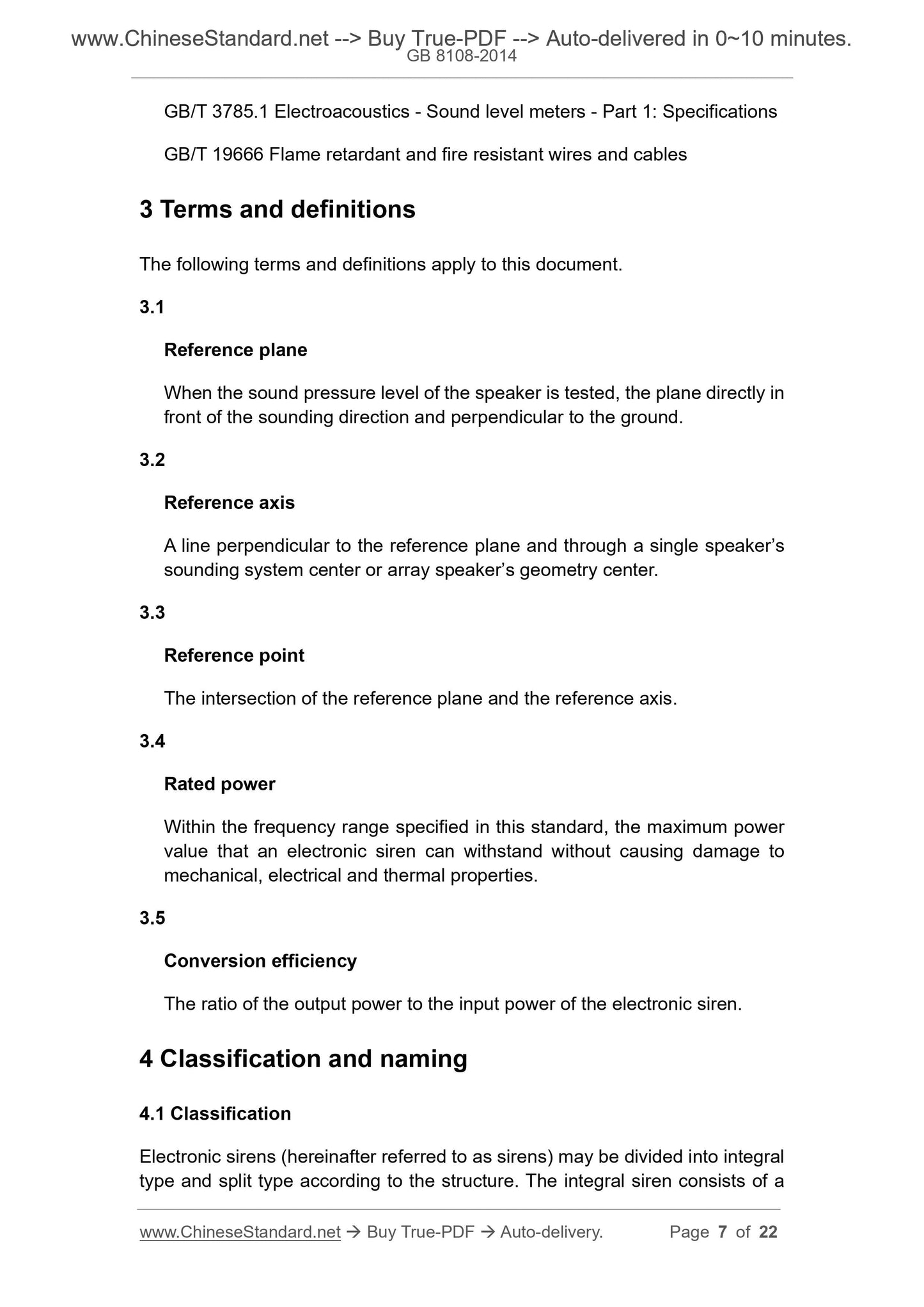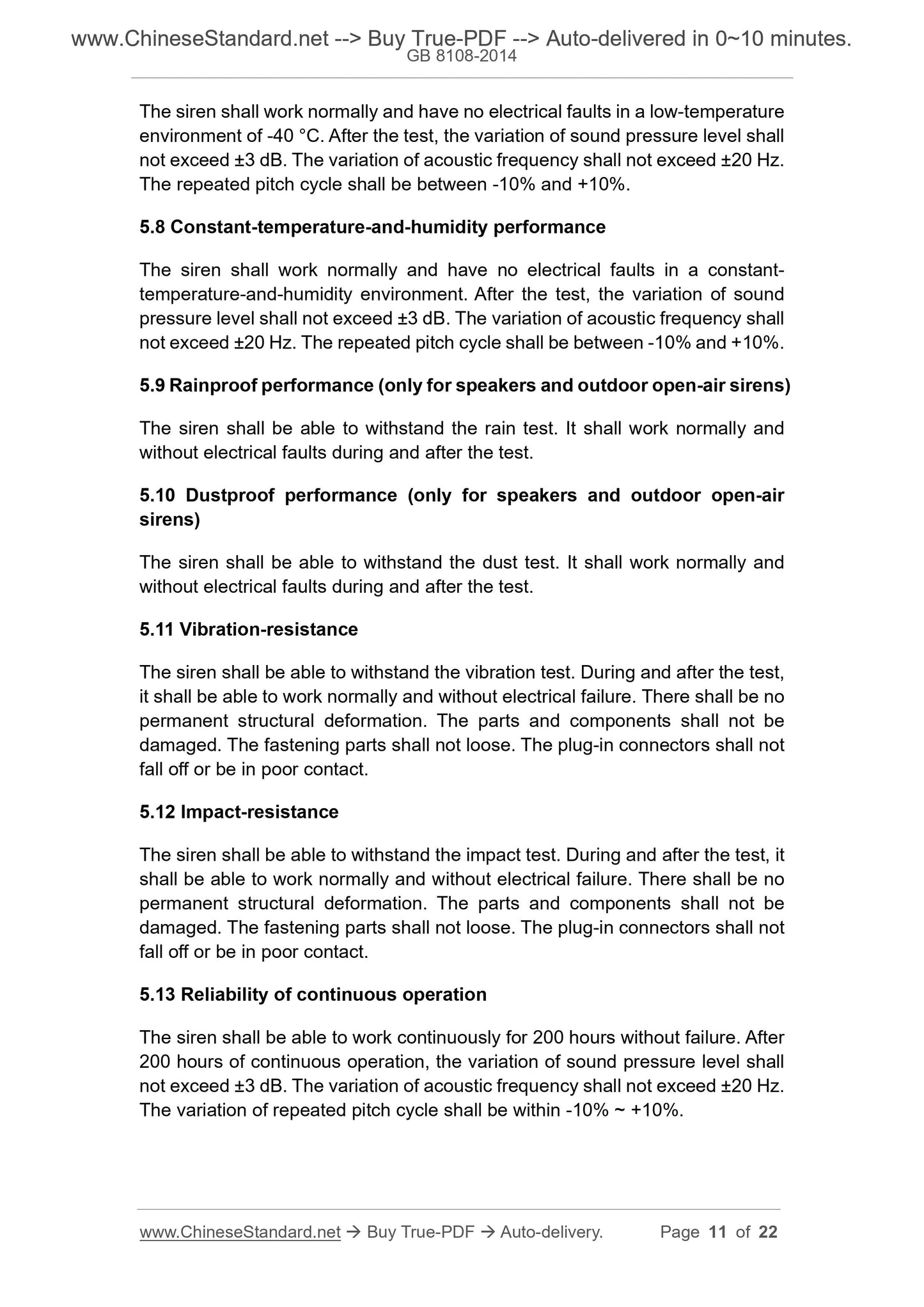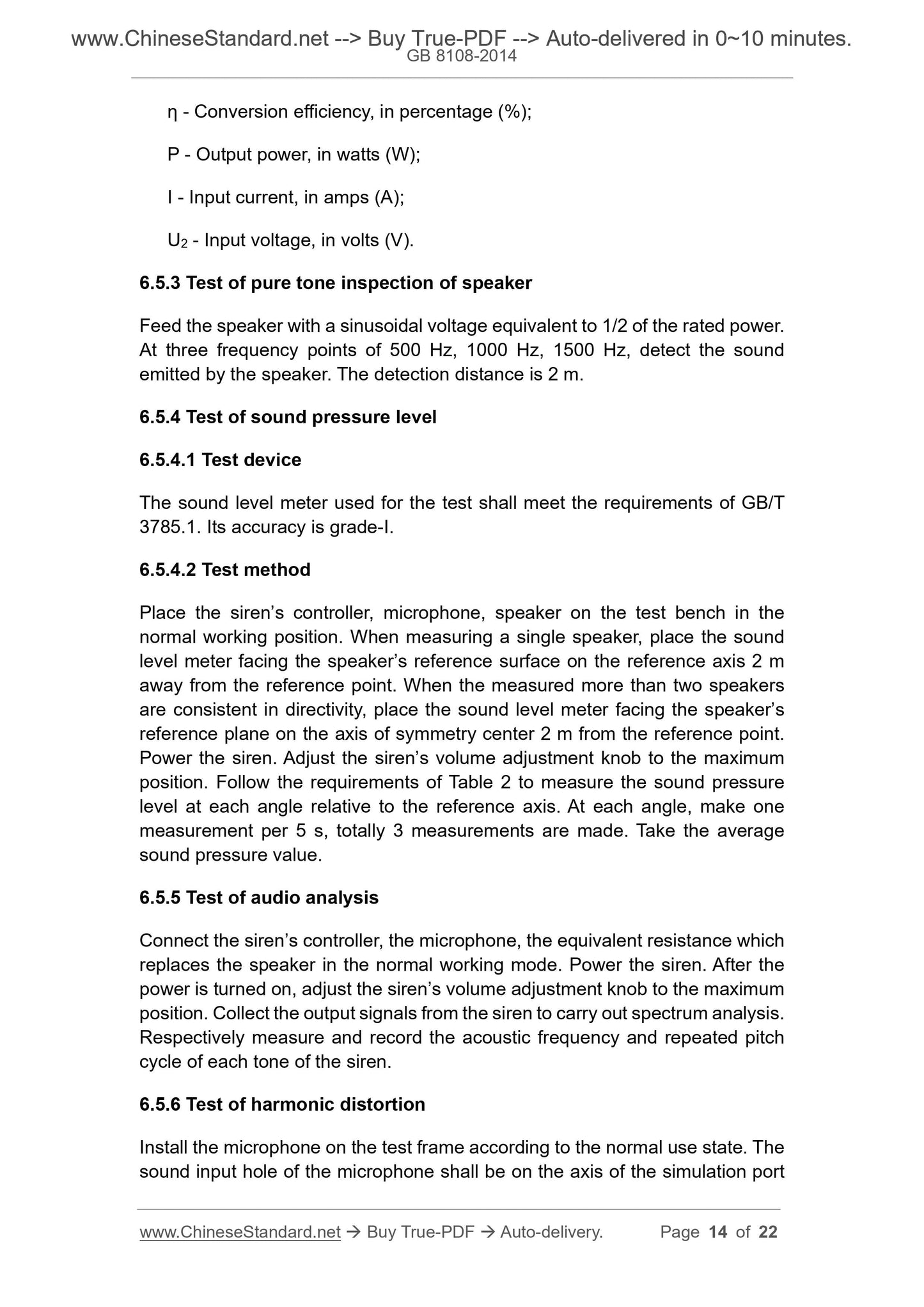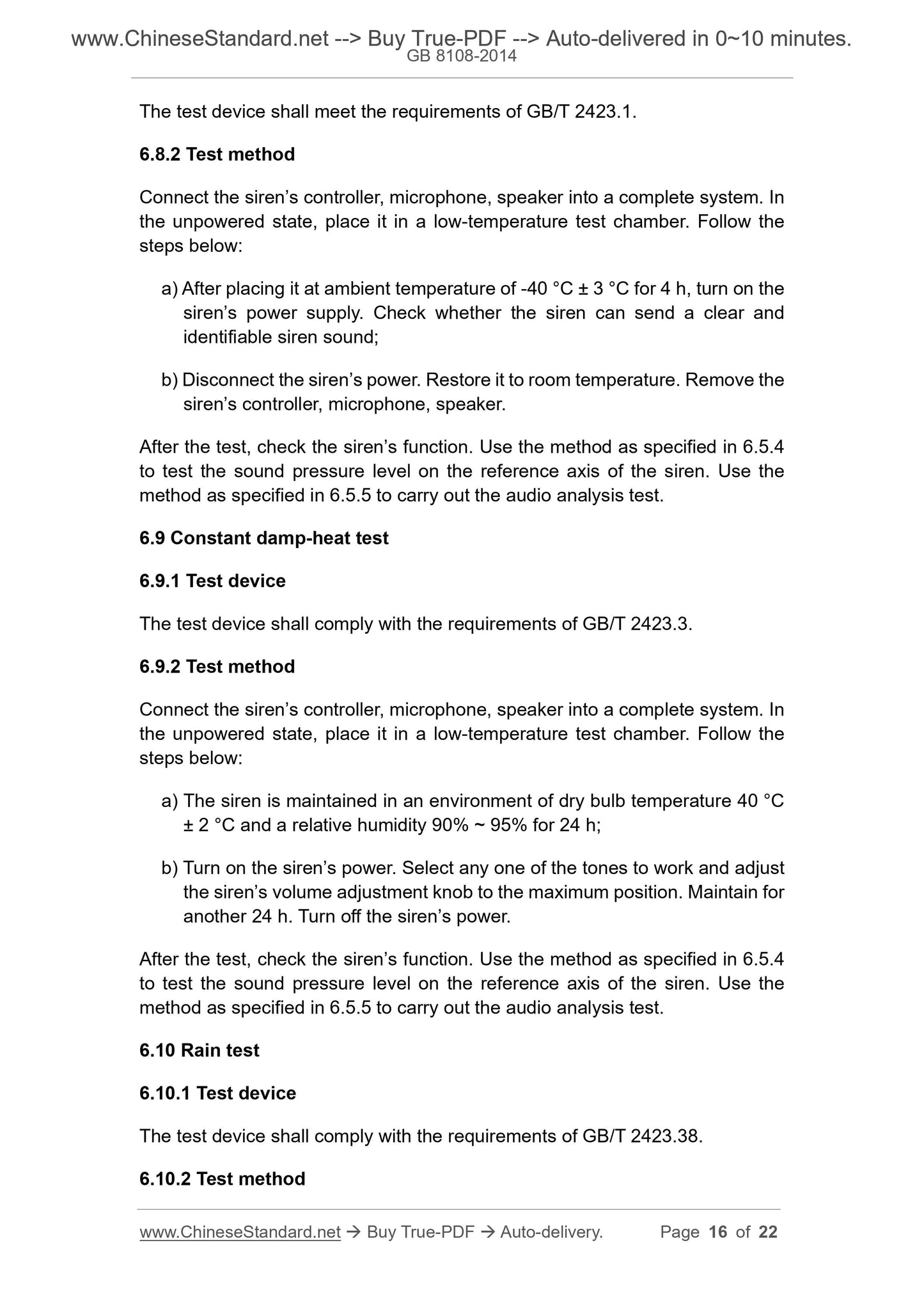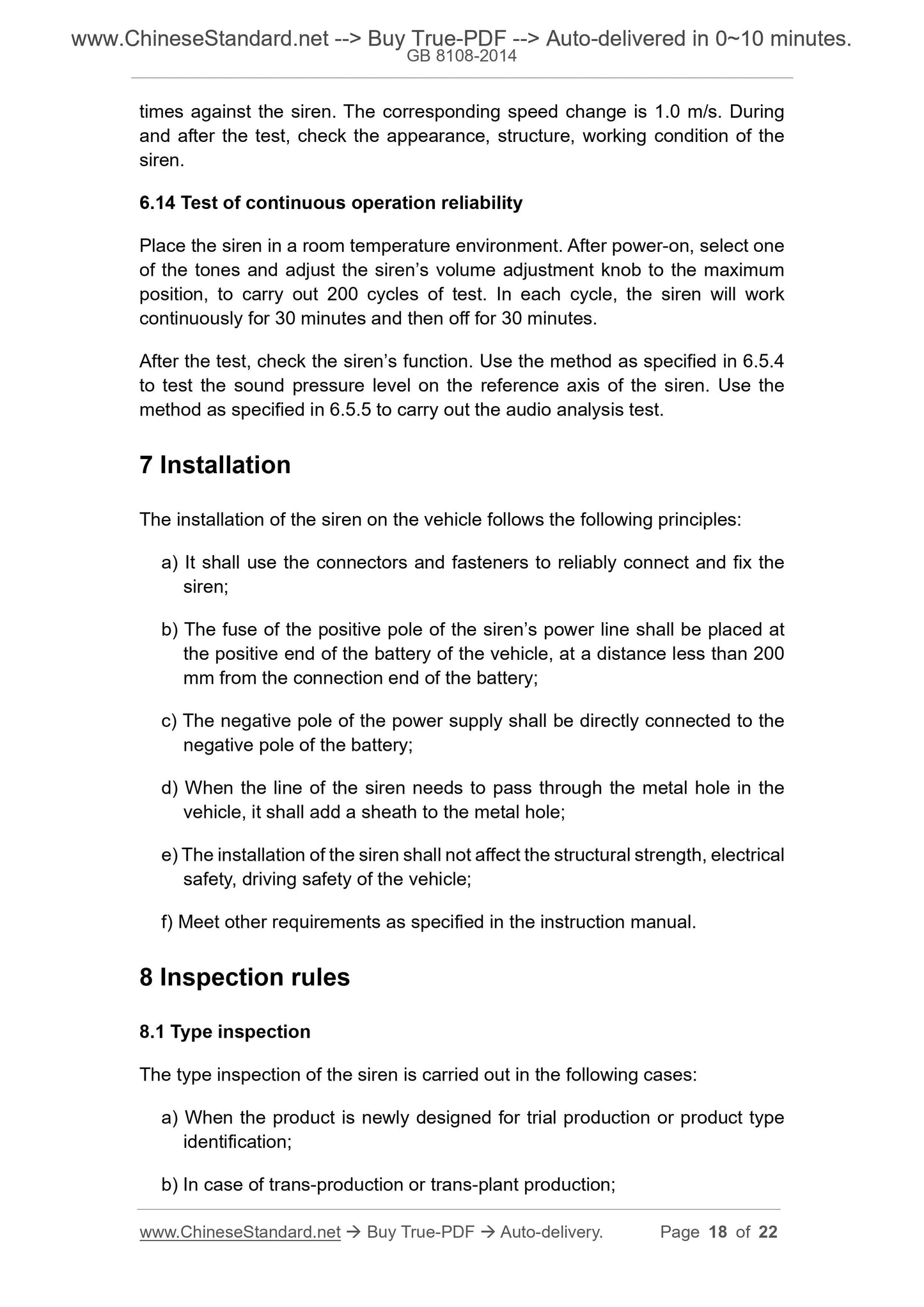PayPal, credit cards. Download editable-PDF & invoice in 1 second!
GB 8108-2014 English PDF (GB8108-2014)
GB 8108-2014 English PDF (GB8108-2014)
Precio habitual
$160.00 USD
Precio habitual
Precio de oferta
$160.00 USD
Precio unitario
/
por
Los gastos de envío se calculan en la pantalla de pago.
No se pudo cargar la disponibilidad de retiro
Delivery: 3 seconds. Download true-PDF + Invoice.
Get QUOTATION in 1-minute: Click GB 8108-2014
Historical versions: GB 8108-2014
Preview True-PDF (Reload/Scroll if blank)
GB 8108-2014: Vehicle-used electronic siren
GB 8108-2014
NATIONAL STANDARD OF THE
PEOPLE’S REPUBLIC OF CHINA
ICS 13.320
A 91
Replacing GB 8108-1999
Vehicle electronic sirens
ISSUED ON: DECEMBER 05, 2014
IMPLEMENTED ON: JULY 01, 2015
Issued by: General Administration of Quality Supervision, Inspection and
Quarantine of PRC;
Standardization Administration of PRC.
Table of Contents
Foreword ... 3
1 Scope ... 5
2 Normative references ... 5
3 Terms and definitions ... 6
4 Classification and naming ... 6
5 Requirements ... 7
6 Test methods ... 11
7 Installation ... 17
8 Inspection rules ... 17
9 Markings, certificates, packaging ... 19
References ... 21
Foreword ... 4
1 Scope ... 6
2 Normative references ... 6
3 Terms and definitions ... 7
4 Classification and naming ... 7
5 Requirements ... 8
6 Test methods ... 12
7 Installation ... 18
8 Inspection rules ... 18
9 Markings, certificates, packaging ... 20
Foreword
Clause 5 (except for 5.1), clause 7, clause 9.1 of this standard are
mandatory. The rest is recommended.
This standard was drafted in accordance with the rules given in GB/T 1.1-2009.
This standard replaces GB 8108-1999 “Vehicle electronic sirens”. As compared
with GB 8108-1999, except for editorial modifications, the main technical
changes are as follows:
- MODIFY the Scope (see clause 1; clause 1 of the 1999 version);
- MODIFY the normative references (see clause 2; clause 2 of the 1999
version);
- MODIFY the definition of reference plane, reference axis, reference point
(see clause 3.1, 3.2, 3.3; clause 3.1, 3.2, 3.3 of the 1999 version);
- ADD the definition of conversion efficiency (see 3.5);
- MODIFY the classification and naming (see clause 4; clause 4 of the 1999
version);
- ADD the requirements for electrical components (see 5.2);
- ADD the requirements for basic functions (see 5.3);
- ADD the requirements for output power (see 5.4);
- MODIFY the requirements for sound pressure level (see 5.4.4; 5.5 of the
1999 version);
- MODIFY the requirements for the acoustic frequency and repeated pitch
cycle of each tone of the siren (see 5.4.5; 5.6 of 1999 version);
- ADD the electrical performance (see 5.5, 6.6);
- DELETE the voltage fluctuation test (5.7, 5.11, 6.4 of the 1999 version);
- DELETE the requirements of various test results as compared with the
parameters measured during the sound pressure level test (5.11 of 1999
version);
- DELETE the requirements of various test results as compared with the
parameters measured during the audio analysis test (5.12 of the 1999
version);
Vehicle electronic sirens
1 Scope
This standard specifies the classification, requirements, test methods,
installation, inspection rules, markings, certificates, packaging for electronic
sirens installed on police cars, fire engines, ambulances, engineering rescue
vehicles.
This standard applies to electronic sirens installed on police cars, fire engines,
ambulances, engineering rescue vehicles.
2 Normative references
The following documents are essential to the application of this document. For
the dated documents, only the versions with the dates indicated are applicable
to this document; for the undated documents, only the latest version (including
all the amendments) are applicable to this standard.
GB/T 2423.1 Environmental testing for electric and electronic and electronic
products - Part 2: Test methods - Tests A: Cold
GB/T 2423.2 Environmental testing for electric and electronic products - Part
2: Test methods - Tests B: Dry heat
GB/T 2423.3 Environmental testing for electric and electronic products - Part
2: Testing method - Test Cab: Damp heat steady state
GB/T 2423.6 Environmental testing for electric and electronic products - Part
2: Test methods - Test Eb and guidance: Bump
GB/T 2423.10 Environmental testing for electric and electronic products -
Part 2: Tests methods - Test Fc: Vibration (sinusoidal)
GB/T 2423.37 Environmental testing for electric and electronic products -
Part 2: Test methods - Test L: Dust and sand
GB/T 2423.38 Environmental testing for electric and electronic products -
Part 2: Test methods - Test R: Water test method and guidance
GB/T 3767 Acoustics - Determination of sound power levels and sound
energy levels of noise sources using sound pressure - Engineering methods
for an essentially free field over a reflecting plane
GB/T 3785.1 Electroacoustics - Sound level meters - Part 1: Specifications
GB/T 19666 Flame retardant and fire resistant wires and cables
3 Terms and definitions
The following terms and definitions apply to this document.
3.1
Reference plane
When the sound pressure level of the speaker is tested, the plane directly in
front of the sounding direction and perpendicular to the ground.
3.2
Reference axis
A line perpendicular to the reference plane and through a single speaker’s
sounding system center or array speaker’s geometry center.
3.3
Reference point
The intersection of the reference plane and the reference axis.
3.4
Rated power
Within the frequency range specified in this standard, the maximum power
value that an electronic siren can withstand without causing damage to
mechanical, electrical and thermal properties.
3.5
Conversion efficiency
The ratio of the output power to the input power of the electronic siren.
4 Classification and naming
4.1 Classification
Electronic sirens (hereinafter referred to as sirens) may be divided into integral
type and split type according to the structure. The integral siren consists of a
The siren shall work normally and have no electrical faults in a low-temperature
environment of -40 °C. After the test, the variation of sound pressure level shall
not exceed ±3 dB. The variation of acoustic frequency shall not exceed ±20 Hz.
The repeated pitch cycle shall be between -10% and +10%.
5.8 Constant-temperature-and-humidity performance
The siren shall work normally and have no electrical faults in a constant-
temperature-and-humidity environment. After the test, the variation of sound
pressure level shall not exceed ±3 dB. The variation of acoustic frequency shall
not exceed ±20 Hz. The repeated pitch cycle shall be between -10% and +10%.
5.9 Rainproof performance (only for speakers and outdoor open-air sirens)
The siren shall be able to withstand the rain test. It shall work normally and
without electrical faults during and after the test.
5.10 Dustproof performance (only for speakers and outdoor open-air
sirens)
The siren shall be able to withstand the dust test. It shall work normally and
without electrical faults during and after the test.
5.11 Vibration-resistance
The siren shall be able to withstand the vibration test. During and after the test,
it shall be able to work normally and without electrical failure. There shall be no
permanent structural deformation. The parts and components shall not be
damaged. The fastening parts shall not loose. The plug-in connectors shall not
fall off or be in poor contact.
5.12 Impact-resistance
The siren shall be able to withstand the impact test. During and after the test, it
shall be able to work normally and without electrical failure. There shall be no
permanent structural deformation. The parts and components shall not be
damaged. The fastening parts shall not loose. The plug-in connectors shall not
fall off or be in poor contact.
Get QUOTATION in 1-minute: Click GB 8108-2014
Historical versions: GB 8108-2014
Preview True-PDF (Reload/Scroll if blank)
GB 8108-2014: Vehicle-used electronic siren
GB 8108-2014
NATIONAL STANDARD OF THE
PEOPLE’S REPUBLIC OF CHINA
ICS 13.320
A 91
Replacing GB 8108-1999
Vehicle electronic sirens
ISSUED ON: DECEMBER 05, 2014
IMPLEMENTED ON: JULY 01, 2015
Issued by: General Administration of Quality Supervision, Inspection and
Quarantine of PRC;
Standardization Administration of PRC.
Table of Contents
Foreword ... 3
1 Scope ... 5
2 Normative references ... 5
3 Terms and definitions ... 6
4 Classification and naming ... 6
5 Requirements ... 7
6 Test methods ... 11
7 Installation ... 17
8 Inspection rules ... 17
9 Markings, certificates, packaging ... 19
References ... 21
Foreword ... 4
1 Scope ... 6
2 Normative references ... 6
3 Terms and definitions ... 7
4 Classification and naming ... 7
5 Requirements ... 8
6 Test methods ... 12
7 Installation ... 18
8 Inspection rules ... 18
9 Markings, certificates, packaging ... 20
Foreword
Clause 5 (except for 5.1), clause 7, clause 9.1 of this standard are
mandatory. The rest is recommended.
This standard was drafted in accordance with the rules given in GB/T 1.1-2009.
This standard replaces GB 8108-1999 “Vehicle electronic sirens”. As compared
with GB 8108-1999, except for editorial modifications, the main technical
changes are as follows:
- MODIFY the Scope (see clause 1; clause 1 of the 1999 version);
- MODIFY the normative references (see clause 2; clause 2 of the 1999
version);
- MODIFY the definition of reference plane, reference axis, reference point
(see clause 3.1, 3.2, 3.3; clause 3.1, 3.2, 3.3 of the 1999 version);
- ADD the definition of conversion efficiency (see 3.5);
- MODIFY the classification and naming (see clause 4; clause 4 of the 1999
version);
- ADD the requirements for electrical components (see 5.2);
- ADD the requirements for basic functions (see 5.3);
- ADD the requirements for output power (see 5.4);
- MODIFY the requirements for sound pressure level (see 5.4.4; 5.5 of the
1999 version);
- MODIFY the requirements for the acoustic frequency and repeated pitch
cycle of each tone of the siren (see 5.4.5; 5.6 of 1999 version);
- ADD the electrical performance (see 5.5, 6.6);
- DELETE the voltage fluctuation test (5.7, 5.11, 6.4 of the 1999 version);
- DELETE the requirements of various test results as compared with the
parameters measured during the sound pressure level test (5.11 of 1999
version);
- DELETE the requirements of various test results as compared with the
parameters measured during the audio analysis test (5.12 of the 1999
version);
Vehicle electronic sirens
1 Scope
This standard specifies the classification, requirements, test methods,
installation, inspection rules, markings, certificates, packaging for electronic
sirens installed on police cars, fire engines, ambulances, engineering rescue
vehicles.
This standard applies to electronic sirens installed on police cars, fire engines,
ambulances, engineering rescue vehicles.
2 Normative references
The following documents are essential to the application of this document. For
the dated documents, only the versions with the dates indicated are applicable
to this document; for the undated documents, only the latest version (including
all the amendments) are applicable to this standard.
GB/T 2423.1 Environmental testing for electric and electronic and electronic
products - Part 2: Test methods - Tests A: Cold
GB/T 2423.2 Environmental testing for electric and electronic products - Part
2: Test methods - Tests B: Dry heat
GB/T 2423.3 Environmental testing for electric and electronic products - Part
2: Testing method - Test Cab: Damp heat steady state
GB/T 2423.6 Environmental testing for electric and electronic products - Part
2: Test methods - Test Eb and guidance: Bump
GB/T 2423.10 Environmental testing for electric and electronic products -
Part 2: Tests methods - Test Fc: Vibration (sinusoidal)
GB/T 2423.37 Environmental testing for electric and electronic products -
Part 2: Test methods - Test L: Dust and sand
GB/T 2423.38 Environmental testing for electric and electronic products -
Part 2: Test methods - Test R: Water test method and guidance
GB/T 3767 Acoustics - Determination of sound power levels and sound
energy levels of noise sources using sound pressure - Engineering methods
for an essentially free field over a reflecting plane
GB/T 3785.1 Electroacoustics - Sound level meters - Part 1: Specifications
GB/T 19666 Flame retardant and fire resistant wires and cables
3 Terms and definitions
The following terms and definitions apply to this document.
3.1
Reference plane
When the sound pressure level of the speaker is tested, the plane directly in
front of the sounding direction and perpendicular to the ground.
3.2
Reference axis
A line perpendicular to the reference plane and through a single speaker’s
sounding system center or array speaker’s geometry center.
3.3
Reference point
The intersection of the reference plane and the reference axis.
3.4
Rated power
Within the frequency range specified in this standard, the maximum power
value that an electronic siren can withstand without causing damage to
mechanical, electrical and thermal properties.
3.5
Conversion efficiency
The ratio of the output power to the input power of the electronic siren.
4 Classification and naming
4.1 Classification
Electronic sirens (hereinafter referred to as sirens) may be divided into integral
type and split type according to the structure. The integral siren consists of a
The siren shall work normally and have no electrical faults in a low-temperature
environment of -40 °C. After the test, the variation of sound pressure level shall
not exceed ±3 dB. The variation of acoustic frequency shall not exceed ±20 Hz.
The repeated pitch cycle shall be between -10% and +10%.
5.8 Constant-temperature-and-humidity performance
The siren shall work normally and have no electrical faults in a constant-
temperature-and-humidity environment. After the test, the variation of sound
pressure level shall not exceed ±3 dB. The variation of acoustic frequency shall
not exceed ±20 Hz. The repeated pitch cycle shall be between -10% and +10%.
5.9 Rainproof performance (only for speakers and outdoor open-air sirens)
The siren shall be able to withstand the rain test. It shall work normally and
without electrical faults during and after the test.
5.10 Dustproof performance (only for speakers and outdoor open-air
sirens)
The siren shall be able to withstand the dust test. It shall work normally and
without electrical faults during and after the test.
5.11 Vibration-resistance
The siren shall be able to withstand the vibration test. During and after the test,
it shall be able to work normally and without electrical failure. There shall be no
permanent structural deformation. The parts and components shall not be
damaged. The fastening parts shall not loose. The plug-in connectors shall not
fall off or be in poor contact.
5.12 Impact-resistance
The siren shall be able to withstand the impact test. During and after the test, it
shall be able to work normally and without electrical failure. There shall be no
permanent structural deformation. The parts and components shall not be
damaged. The fastening parts shall not loose. The plug-in connectors shall not
fall off or be in poor contact.
Share
